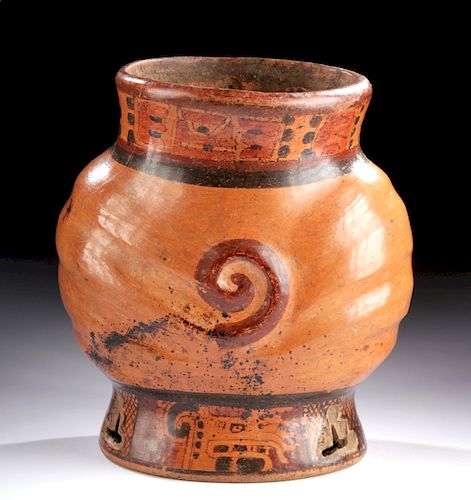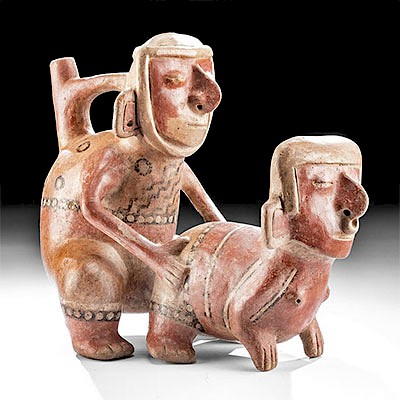Maya Ulua Valley Polychrome Gourd-Shaped Olla
Lot 4a
About Seller
Artemis Fine Arts
686 S Taylor Ave, Ste 106
Louisville, CO 80027
United States
Selling antiquities, ancient and ethnographic art online since 1993, Artemis Gallery specializes in Classical Antiquities (Egyptian, Greek, Roman, Near Eastern), Asian, Pre-Columbian, African / Tribal / Oceanographic art. Our extensive inventory includes pottery, stone, metal, wood, glass and textil...Read more
Categories
Estimate:
$2,200 - $3,300
Absentee vs Live bid
Two ways to bid:
- Leave a max absentee bid and the platform will bid on your behalf up to your maximum bid during the live auction.
- Bid live during the auction and your bids will be submitted real-time to the auctioneer.
Bid Increments
| Price | Bid Increment |
|---|---|
| $0 | $25 |
| $300 | $50 |
| $1,000 | $100 |
| $2,000 | $250 |
| $5,000 | $500 |
| $10,000 | $1,000 |
| $20,000 | $2,500 |
| $50,000 | $5,000 |
| $100,000 | $10,000 |
| $200,000 | $20,000 |
About Auction
By Artemis Fine Arts
Jan 30, 2020
Set Reminder
2020-01-30 10:00:00
2020-01-30 10:00:00
America/New_York
Bidsquare
Bidsquare : Pre-Columbian | Tribal | Ethnographic
https://www.bidsquare.com/auctions/artemis-gallery/pre-columbian-tribal-ethnographic-4830
Featuring ancient and ethnographic art from around the world, including Pre-Columbian, Native American, African / Tribal, Oceanic, Ethnographic, Spanish Colonial, Fossils, Fine Art, much more. Artemis Fine Arts info@artemisgallery.com
Featuring ancient and ethnographic art from around the world, including Pre-Columbian, Native American, African / Tribal, Oceanic, Ethnographic, Spanish Colonial, Fossils, Fine Art, much more. Artemis Fine Arts info@artemisgallery.com
- Lot Description
Pre-Columbian, Honduras, Maya Ulua Valley, ca. 550 to 850 CE. A fascinatingly-shaped ceramic vessel with a ridged body and spiral-shaped central point on its two flattened sides, resembling a small pumpkin or gourd on its side. A symmetrical flaring ovoid foot and neck complete the vessel's unusual form. The body is painted a warm, yam-colored orange with the central spiral a richly hued wine red. The foot and neck, meanwhile, have complex black-outlined iconography. The foot has three openwork stepped forms - resembling the altars at the top of Mayan pyramids - and then is painted with a repeated fantastical face - probably a version of the winged serpent god, known as Kukulkan to the Maya and Quetzalcoatl elsewhere in Mesoamerica. Around the neck are abstract, glyphoid motifs that in some places resemble human faces seen in profile and elsewhere are geometric forms. Size: 5.75" W x 6.6" H (14.6 cm x 16.8 cm)
The Ulua Valley, centered around the large city of Cerro Palenque, is a mystery for archaeologists - unlike the Maya, they left no written records (the glyphoid designs on this vessel do not form words), and their connection to the Classic Maya is unclear. It seems to have been a point of trade and transport - a connecting link - between the Maya world further north and Central America. The pottery from the Ulua Valley is part of a very unique tradition different even from those found at nearby Copan.
Provenance: private New York, New York, USA collection; ex Miami Beach, Florida, USA collection
All items legal to buy/sell under U.S. Statute covering cultural patrimony Code 2600, CHAPTER 14, and are guaranteed to be as described or your money back.
A Certificate of Authenticity will accompany all winning bids.
We ship worldwide and handle all shipping in-house for your convenience.
#149185Two hairline fissures on one side of the rim. These appear to be stable. Pitting on interior, but exterior is in fantastic condition with manganese deposits and beautifully preserved pigment.Condition
- Shipping Info
-
All shipping is handled in-house for your convenience. Your invoice from Artemis Gallery will include shipping calculation instructions. If in doubt, please inquire BEFORE bidding for estimated shipping costs for individual items.
-
- Buyer's Premium



 EUR
EUR CAD
CAD AUD
AUD GBP
GBP MXN
MXN HKD
HKD CNY
CNY MYR
MYR SEK
SEK SGD
SGD CHF
CHF THB
THB
















